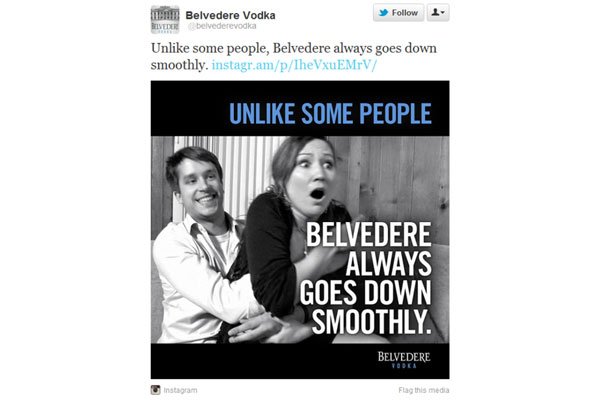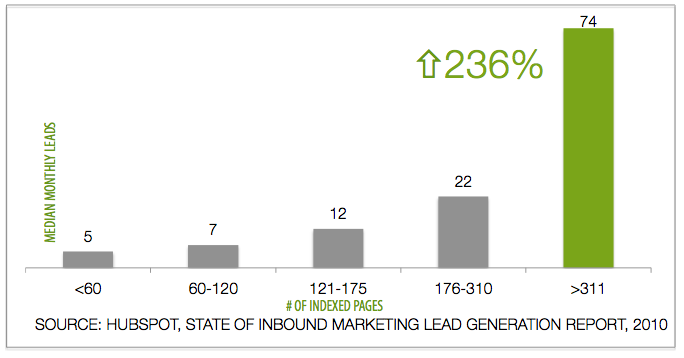 While the digital advertising industry is always abuzz with best practices, hottest trends, and catchphrases, it unfortunately lacks direction. For instance, everyone knows content marketing is an awesome strategy, but ask business owners or marketers what it really is and why you need it and only a few will be able to give definitive answers.
While the digital advertising industry is always abuzz with best practices, hottest trends, and catchphrases, it unfortunately lacks direction. For instance, everyone knows content marketing is an awesome strategy, but ask business owners or marketers what it really is and why you need it and only a few will be able to give definitive answers.
[Read more…]
Category: Branding
Tips and advice about making your Web marketing efforts more effective, with a focus on branding issues. Including issues around Web design, usability, user experience and more. From Toronto digital marketing agency Fruition Interactive.
The business case for your blog
A big part of our work as a digital marketing agency involves talking to clients and prospective clients about creating quality Web site content on a regular basis, or what a lot of the world calls “blogging.”
And we get challenged on it. A lot. “We don’t have time to write that stuff,” “I hate writing that stuff,” “nobody would read our blog.” These are all common objections that we hear.
But you should make time – or hire someone who’s good at it who has the time – and people will read it if it’s done right. In fact, according to HubSpot, companies that blog generate 70% to 90% more leads than comparable companies that don’t blog. And I’m going to guess, although I don’t have hard statistically valid data to back it up, that companies that blog convert those leads into sales at a higher rate, too.
Here’s why…
Why most marketing fails
 As the owner of an online marketing company, I get to sit in on a fair number of advertising agency pitches and briefings with our clients. And more often than not, the pitches are a variation on “clever creative spots” or “bold brand ideas”.
As the owner of an online marketing company, I get to sit in on a fair number of advertising agency pitches and briefings with our clients. And more often than not, the pitches are a variation on “clever creative spots” or “bold brand ideas”.
It’s not surprising – these things have been marketing agencies’ bread and butter since before Don Draper strapped on his first Brooks Brothers’ suit.
But it is less and less convincing.
Walmart’s Mistake: How to Lose Marketshare Overnight and Drive Customers Away
Recently, I heard a news report, which claimed Walmart had lost market share to its competitors over the past few quarters. This statement, alone, did not seem “out of the ordinary” or odd considering the economic climate we’ve experienced over the past two years or so.
I did, however, find the reason for this decline somewhat interesting. As it turns out, Walmart did what a lot of businesses sometimes do when looking to grow. They focus on a new market instead of re-focusing their efforts on retaining or attracting more of their core customers.
At some point, during the economic slowdown, Walmart changed their strategy in an effort to attract middle–class families. This seemed to work - for awhile. However, for some reason, their core customer (lower income families) started to shop elsewhere.
Then, as the economy began to pick up steam, middle-class families who shopped at Walmart during the slowdown went back to their old shopping habits and dropped the big-box store from their weekly shopping trips.
This is a situation many businesses face on a regular basis, including Fruition Interactive. When you try to appeal to everybody you end up reaching no one. Forgetting who your best or core clients and customers are can be disastrous, as we’ve seen here with the Walmart example.
Onward.
photo credit : ogimogi
15 Ways To Increase Your Conversion Online
Recently, I wrote an article called Is Your Website Converting Leads into Gold? In it, I discussed the importance of optimizing your website or landing page for lead conversion.
With that in mind, here are 15 additional ways to increase your conversion online:
1. Keep your most important sales elements “above the fold” (ideally on your home page, without scrolling). This usually means putting your most interesting content with a convincing call-to-action and perhaps even a photo of you (to build trust and rapport). Tip: Tools like CrazyEgg can help reveal your most important content that should be at the top left side of your page.
2. Are you using a standard and up-to-date web design or blog theme? Navigation should be immediately understandable. Is there a lot of distracting navigation leading your customers away? Remove it.
3. Let prospects know they’re buying from a human being. Keep the copy personal, friendly, and (for most markets) informal. Sound like a person, not a robot.
4. Simplify your content.
5. Do your headline and subheads tell an intriguing story if you read them without any of the rest of the copy?
6. Make the first paragraph easy to read.
7. What’s the experience of using your service? Could you make that more vivid with a testimonial video or a great case study? (we’re currently in the process of doing this for ourselves)
8. Got testimonials? Use them.
9. Is your message confusing? Can a bright ten-year old read your sales copy and figure out why they should use your service. You might be an expert in your industry, but your prospects aren’t.
10. How often are you using the word “You”? Can it be increased?
11. Have you made yourself an authority in your market?
12. Throw in some more proof that what you’re saying is true. Proof can come from statistics, testimonials, case studies, even news stories or current events that illustrate the ideas your product or service is based on.
13. If you demand a pretty penny for your services make sure your web design and content is congruent? If your average client brings in $15,000 annually, make sure you own your own domain and its not a site your nephew built (unless they’re really that good).
14. Cut all long paragraphs into shorter ones. Make sure there are enough subheads so you have at least one per screen. If copy looks daunting to read, it doesn’t get read.
15. Increase your font size.
Did I miss any?
About the Author:
Mitch Fanning is VP of Strategy & Business Development for Fruition Interactive (Toronto, Canada), a professional member of Social Media Club, and founding member of Social Media Club Niagara. He’s spent 10 plus years working with businesses of all sizes, from global brands – to mid-sized B2B companies – to some of Canada’s fastest growing Internet start-ups ranked in the PROFIT 100. Follow Mitch on his adventures in new media at [mitchellfanning.com].
Did you like this article? Check out additional articles on optimizing conversion here.
What You Can Learn From the “Cake Boss”
Cake Boss is a show about Carlo’s Bake Shop in Hoboken, New Jersey. The show, which premiered on TLC in 2009, stars Buddy Valastro, the shop’s owner — and his family — and depicts their everyday lives running the bakery.
Due to the popularity of the show, business for Carlo’s Bake Shop — as well as tourism to the Hoboken area — has skyrocketed. Anyone who lives in the Hoboken, New Jersey area instinctively knows that if they need a wedding or specialty cake, Carlo’s Bake Shop is the place to go.
So what does a reality television show have to do with your business?
Branding your WHOLE Web site to inspire action
It’s more than just a logo
I hear a lot of business people — and a lot of branding specialist, who should know better — talk about branding as if it were just a logo, or just a visual identity for an organization. But a brand is so much more than that. It’s about the total experience of your business and how that experience connects with and appeals to your customers.
Take Apple, for instance. They don’t have a great brand because they have a great logo. They have a great brand because they offer simple, elegant experiences that work like magic. The logo is just a symbol of that experience.
A great visual identity can be an effective short-hand for a promise of a great experience. But a great brand experience can inspire people to take action. And a key element of your brand’s experience is your Web site.
3 elements of an experience
In order for your brand experience — and your Web site — to be effective it needs to connect with your customer on 3 different dimensions:
- Aesthetic – this is the sensual dimension of the brand: how it tastes, what it smells like, what it looks like.
- Meaning – this is the social impact dimension of the brand. For instance, fair trade coffee has a meaning above and beyond what the coffee tastes like or how effectively it perks you up. This can speak to people’s aspirations of who they want to be, as well.
- Benefit – this is the “what’s in it for me” dimension. How does your product or service tangibly make life easier for your customers.
So how do you get your Web site to connect with your customers? You’ve got 3 main tools:
- content (perhaps the most overlooked of the 3)
- design
- navigation.
Each of those elements has to reflect
- the sensual experience your customers want — is it fun? is it staid? is it dependable? is it innovative?
- the aspirational aspects your customers want — how does it make people or the world better or different?
- the logical, tangible immediate benefits your business can bring
If they don’t, or if they’re pulling in different directions, you’re missing an opportunity to influence and inspire and to get the full benefit your site can bring.
Why Web site usability matters
At Fruition, we talk a lot about Web site usability and good online user experience. It’s kind of what we do around here. But as a business person, why should you care about whether your Web site is clean-looking and easy to navigate?
It’s about conversions
Increasing your site’s conversion rate is the easiest and most cost-effective way to generate new leads and new revenue from your site. Period. You don’t need to spend a dime on driving new traffic to your site to generate additional revenue if you can increase the number of your current visitors who become customers. And the payoffs can be huge.
Let’s take, for example, a site that gets 20,000 unique visitors in a month. There are a lot of sites that do this kind of traffic. If we can increase their conversion rate — the percentage of those visitors that become customers — by 1%, that’s 200 new customers a month.
What’s the lifetime value of a customer to your business? For a lot of our clients, that number is in the thousands or tens of thousands of dollars. And what would you spend to increase your sales by $200,000 a month?
So how does Web site usability factor into this math?
The Old Spice Man backlash has started. Is it justified?
So the Old Spice Man backlash has begun.
Time (speaking of brands that could use an update), is calling the campaign a #fail because sales have reportedly dropped by 7% (comparing June 09/10 to the previous year. The blogosphere’s piling on, too, with BNet and Jezebel taking a few kicks at the Man Your Man Could Smell Like (and I don’t know about you, but I get ALL of my marketing advice from Jezebel).
So how could this be? The Man has had over 12 million YouTube views and counting, they’ve had thousands of people participate in their interactive video push, they’ve had more positive earned media mentions than anyone other than their PR agency can count. By every “soft” category of measurement — exposure, engagement, influence — Old Spice Man has been a HUGE success.
So why isn’t that translating into hard ROI?
Jezebel has a theory — it’s about gender (surprise) — and the industry is starting to play this as a repeat of the old “great creative doesn’t get results” story.
I’ve got another theory: the numbers are bullshit (for now).
Leaving aside the fact that the sales data exclude WalMart, let’s look at the time period. Years ending June 2009 vs June 2010.
Old Spice Man launched in February of 2010, so on the surface it makes sense that you should see some lift in the units sold data for year ending June 2010.
But The Man didn’t really start to go viral until May/June of this year (at least that’s when I first saw him, and I don’t think I’m THAT far out of the loop)[correction: i just looked it up — I first saw The Man in February, although it feels a lot more recent than that]. And Proctor and Gamble (Old Spice’s parent company) didn’t make their REAL viral push — with their “get a custom message from the Old Spice Man” thing — until mid-July.
Last week I tweeted a link to 7 Social Media Lessons you can Learn form the Old Spice Man. Here’s the 8th lesson: social media marketing takes time.
It takes time to build relationships. It takes time for the people that know, like and trust you to develop the intention to become your customers. Heck, it takes time to run out of body wash and to need to go buy more.
Social media marketing isn’t a campaign. It isn’t something that you can flip a switch on and see lift from next week. It’s a process. A process that’s built on long-term awareness and engagement.
Old Spice Man is building that engagement, so I’m not ready to write him off yet.
Ten ways to turbocharge your business with Facebook
IT Business has put together a little slideshow primer on how to better use Facebook to grow your business.
Most of these tips are more appropriate for business-to-consumer marketing than for B2B, but there are a couple of gems that could benefit any business, like connecting Twitter and your Facebook status to make the most of both.
Ten ways to turbocharge your brand and business with Facebook - IT Business Slideshow Index.



